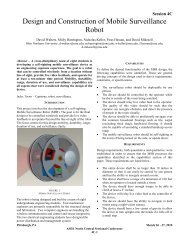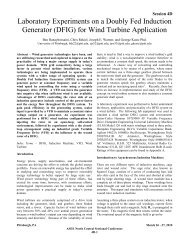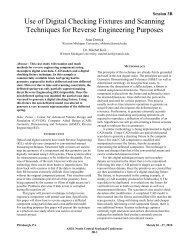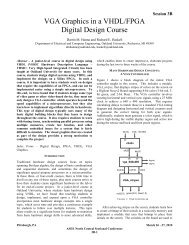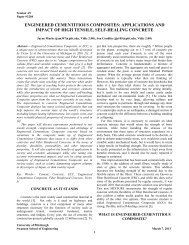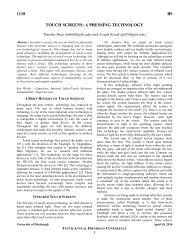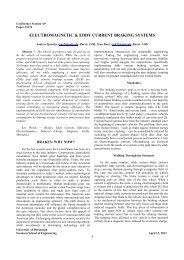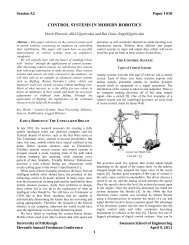THE ECOBOOST ENGINE: COMBINING VARIABLE VALVE TIMING ...
THE ECOBOOST ENGINE: COMBINING VARIABLE VALVE TIMING ...
THE ECOBOOST ENGINE: COMBINING VARIABLE VALVE TIMING ...
Create successful ePaper yourself
Turn your PDF publications into a flip-book with our unique Google optimized e-Paper software.
Neil Debski<br />
Seth Kahanov<br />
FIGURE 2<br />
Port Injection vs. Direct Injection [12]<br />
All gasoline engines depend on atomizing the fuel before<br />
combustion. Unfortunately, with carburetors, throttle bodies,<br />
and even port injection, the atomization takes place at a<br />
distance from the combustion chamber. By the time the<br />
atomized fuel and air reach the combustion chamber, some<br />
of the fuel has separated out and collects on intake.<br />
However, when fuel atomizes and the air and fuel mixture<br />
are cooled in the combustion chamber, a higher compression<br />
ratio is produced thus eliminating the problem. Better<br />
atomization contributes to a reduction in pre-ignition and<br />
detonation, which is why the SIDI engine can operate at a<br />
higher compression ratio and consume less fuel [12]. SIDI<br />
allows the engine to run on a leaner mixture (more air, less<br />
fuel) which allows for better fuel economy at part and full<br />
throttle [12]. The fuel delivery in a SIDI engine comprises of<br />
two components. The low side works with a fuel pump at 60<br />
psi to deliver fuel from the tank to the engine compartment.<br />
The high side, which is located by the cylinder head, is<br />
driven by lobes on the camshaft and delivers fuel at 2,176<br />
psi [12]. The high side, high pressure pump utilizes the fuel<br />
rail’s pressure with an engine control module. This allows<br />
more accurate control over fuel metering (the amount of fuel<br />
injected), and injection timing (exactly when the fuel is<br />
introduced into the cylinder).<br />
Engine knocking is the premature fuel combustion that<br />
can result in power loss of the engine. Engine knocking is<br />
compression detonation or pre-ignition of fuel in the power<br />
stroke of the engine. Knock is a function of heat and<br />
pressure. The fix for engine knock until now has been to<br />
reduce the compression ratio of turbocharged engines. The<br />
compression ratio is the ratio between the cylinder's<br />
maximum and minimum volumes, when the piston is at the<br />
bottom of its stroke versus the top [13]. With direct<br />
injection, the spray of fuel during the compression stroke<br />
helps keep the cylinder cooler, reducing the possibility of<br />
knocking [13]. Like the spray from an atomizer bottle one<br />
might use to keep cool in the summer, the fine mist<br />
generated by each solenoid-controlled injector’s six tiny<br />
outlet holes helps to create a well-mixed air-fuel mixture. It<br />
also cools the incoming air, helping to reduce the potential<br />
for engine knock. This allows for higher compression ratios<br />
which can boost fuel efficiency by a few percent. When<br />
coupled with sophisticated electronic control of how much<br />
fuel to add with the turbo, the end result can be up to a 20<br />
percent increase in fuel efficiency [11]. Better atomization<br />
contributes to a reduction in pre-ignition and detonation,<br />
which is why the spark ignition direct injection engine can<br />
operate at a higher compression ratio and consume less fuel.<br />
The EcoBoost engine has both more peak torque and lower<br />
end torque, meaning direct injection produces a remarkable<br />
flat torque curve. The EcoBoost engine produces 90 percent<br />
of its peak torque between 1,550 and 5,500 rpm. About 98<br />
percent of all driving is between 1,000 and 3,000 rpm [14].<br />
<strong>THE</strong> CRUCIAL <strong>TIMING</strong> OF <strong>VARIABLE</strong><br />
<strong>VALVE</strong> ACTIVITY<br />
The next aspect of the EcoBoost engine that is crucial to<br />
its design is its variable valve timing. This section will<br />
explain how the EcoBoost’s use of variable valve timing<br />
makes the engine fuel efficient as it works along with the<br />
direct fuel injection. We will define variable valve timing by<br />
describing how less overlap between intake and exhaust<br />
strokes allows for better efficiency at low and high speeds<br />
alike. Valve overlap is the time when both intake and<br />
exhaust valves are open, giving an opportunity for exhaust<br />
gas flow and intake flow to influence each other. For<br />
maximum efficiency, valve overlap should allow exiting<br />
exhaust gas to draw an intake charge into the cylinder<br />
without intake gas passing straight to the exhaust system<br />
[15]. At high speeds and torque, output is improved due to<br />
the aided intake of fresh charge due to increased valve<br />
timing. At low speed, the effect of valve overlap is to reintroduce<br />
exhaust gasses into the combustion chamber<br />
[15]. This is known as generating internal exhaust gas recirculation<br />
or internal EGR. Exhaust gas recirculation also<br />
reduces hydrocarbon and NOX emissions by the recirculation<br />
of un-burnt exhaust gasses [15]. The retained<br />
exhaust gasses tend to be very rich in un-burnt<br />
hydrocarbons, as they typically come from the end of the<br />
exhaust stroke. This strategy can therefore be quite effective<br />
at reducing emissions. Each of the three implementations of<br />
variable valve timing uses a cam phaser to adjust the<br />
camshaft angular position relative to the crankshaft position,<br />
referred to as camshaft phasing [15]. A camshaft is a rotating<br />
cylindrical shaft used to regulate the injection of vaporized<br />
fuel in an internal combustion engine, as seen in Figure 3.<br />
The crankshaft is located in the engine of a vehicle and<br />
converts the force created by the engine's pistons moving up<br />
and down into a force that moves the wheels in a circular<br />
motion so the car can go forward.<br />
3




